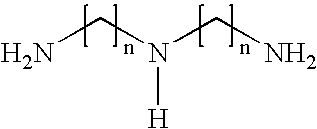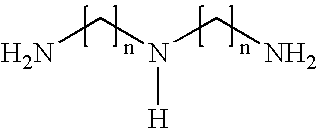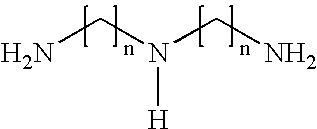Triamine/aspartate curative and coatings comprising the same
a technology of aspartate and curative, which is applied in the field of triamine, can solve the problems of too short potlife or other difficulties in application, and certain aliphatic secondary amines, however, are not reactive enough with these various functionalities
- Summary
- Abstract
- Description
- Claims
- Application Information
AI Technical Summary
Benefits of technology
Problems solved by technology
Method used
Image
Examples
examples
[0054]The following examples are intended to illustrate the invention, and should not be construed as limiting the invention in any way. As will be appreciated by those skilled in the art MW refers to average molecular weight, Mw refers to weight average molecular weight and Mn refers to number average molecular weight.
example a
[0055]An aspartate modified amine curative with a secondary non-aspartate amino group was prepared from the following ingredients:
IngredientWt in gCharge 1Dipropylene triamine2292.52,6-di-tert-butyl p-cresol10.5Charge 2Diethyl maleate5779.2
[0056]Charge 1 was added to a suitable flask equipped with an overhead stirrer, thermocouple, condenser, and N2 inlet. The charge was placed under an N2 blanket. Beginning at a temperature of 22° C., Charge 2 was added to the flask over a period of 6 hours. An exotherm was observed during the addition. A maximum temperature of 49° C. was observed during the addition of this charge. At temperature of 48° C. (3.75 hours into the charge) cooling was applied to the reactor in the form of a stream of air. At a temperature of 49° C. (4.5 hours into the charge) an ice bath was applied to the reactor. At the completion of the charge, the temperature of the reaction mixture was 41° C. The reaction mixture was heated to a temperature of 50° C. with an exter...
example b
[0057]An aspartate modified amine curative with a secondary non-aspartate amino group was prepared from the following ingredients:
IngredientWt in gCharge 1Bishexamethylene triamine172.5Charge 2Diethyl maleate264.1
[0058]Charge 1 was added to a suitable flask equipped with an overhead stirrer, thermocouple, condenser, and N2 inlet. The charge was placed under an N2 blanket. Beginning at a temperature of 60° C., Charge 2 was added to the flask over a period of 4.5 hours. A slight exotherm was observed during the addition. A maximum temperature of 67° C. was observed during the addition of this charge. At the completion of the charge, the temperature of the reaction mixture was 61° C. The reaction mixture was heated to a temperature of 70° C. with an external heat source and held at this temperature for 2.75 hours. Inspection of the infrared spectrum of the reaction mixture indicated consumption of diethyl maleate (disappearance of peak at 1646 cm−1). The resulting material was found to...
PUM
| Property | Measurement | Unit |
|---|---|---|
| temperature | aaaaa | aaaaa |
| temperature | aaaaa | aaaaa |
| temperature | aaaaa | aaaaa |
Abstract
Description
Claims
Application Information
 Login to View More
Login to View More - R&D
- Intellectual Property
- Life Sciences
- Materials
- Tech Scout
- Unparalleled Data Quality
- Higher Quality Content
- 60% Fewer Hallucinations
Browse by: Latest US Patents, China's latest patents, Technical Efficacy Thesaurus, Application Domain, Technology Topic, Popular Technical Reports.
© 2025 PatSnap. All rights reserved.Legal|Privacy policy|Modern Slavery Act Transparency Statement|Sitemap|About US| Contact US: help@patsnap.com



